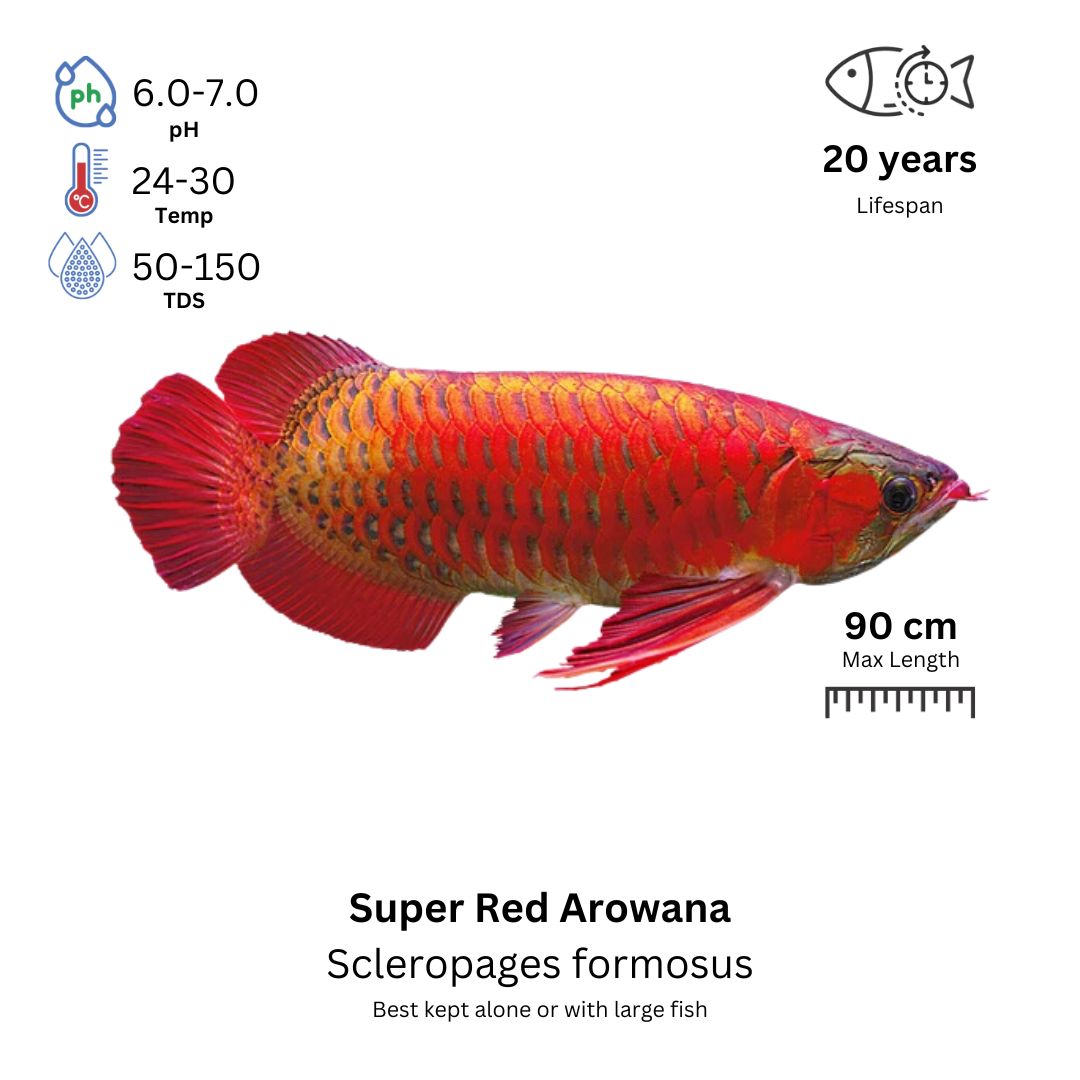Super Red Arowana: Species Profile
The Super Red Arowana (Scleropages formosus), also known as the Red Dragon Fish, is a captivating freshwater species celebrated for its vibrant red coloration and majestic presence. Originating from the rivers and lakes of Southeast Asia, particularly Indonesia, this fish is highly prized among aquarists and holds cultural significance in various Asian traditions.
Species Overview
- Common Names: Super Red Arowana, Red Dragon Fish
- Scientific Name: Scleropages formosus
- Adult Size: Up to 35 inches (90 cm)
- Life Expectancy: 15 to 20 years
Characteristics
- Family: Osteoglossidae
- Origin: Southeast Asia (Indonesia, Malaysia)
- Social: Territorial; best kept alone or with carefully selected tankmates
- Tank Level: Top
- Minimum Tank Size: 250 gallons
- Diet: Carnivore
- Breeding: Mouthbrooder; challenging in captivity
- Care Level: Advanced
- pH: 6.0 to 7.5
- Hardness: 1 to 8 dGH
- Temperature: 75–86°F (24–30°C)
Origin and Distribution
Super Red Arowanas are native to the slow-moving rivers, lakes, and swamps of Southeast Asia, with a significant population in Indonesia. They inhabit freshwater environments rich in vegetation, providing ample cover and hunting grounds.
Colors and Markings
This species is distinguished by its elongated body covered in large, metallic scales that exhibit a vibrant red hue. The intensity of the red coloration can vary, often deepening with age and proper care. Their pectoral and caudal fins typically mirror the body’s red tone, enhancing their striking appearance.
Tankmates
Super Red Arowanas are territorial and can exhibit aggressive behavior, especially towards smaller fish. If considering tankmates, choose large, robust species that can coexist without conflict. Suitable companions include:
- Large catfish species
- Bichirs
- Large cichlids
It’s crucial to monitor interactions closely and provide ample space to reduce territorial disputes.
Habitat and Care
To replicate their natural habitat:
- Tank Setup: Provide a spacious aquarium with a secure lid, as Arowanas are known to jump. Incorporate sturdy driftwood and large rocks to create hiding spots, but ensure ample open swimming space.
- Water Parameters: Maintain stable water conditions within the recommended pH and hardness ranges. Regular water changes and efficient filtration are essential to keep the environment clean and healthy.
- Lighting: Moderate lighting is preferred, which can help showcase their vibrant coloration without causing stress.
Diet and Feeding
Super Red Arowanas are carnivorous predators with a preference for live prey. A balanced diet includes:
- Live or frozen foods such as shrimp, crickets, and mealworms
- Occasional feeder fish, ensuring they are disease-free
- High-quality carnivorous pellets
Feed them once or twice daily, offering only what they can consume within a few minutes to prevent overfeeding and maintain water quality.
Gender Differences
Determining gender in Super Red Arowanas can be challenging, as males and females exhibit similar external features. Subtle differences may include males having a slightly broader head and more elongated pectoral fins, but these distinctions are not always reliable.
Breeding
Breeding Super Red Arowanas in captivity is challenging and requires specific conditions:
- Breeding Tank: A large, secluded tank with optimal water parameters is essential.
- Spawning: After courtship, the female lays eggs, which the male fertilizes and then carries in his mouth for incubation.
- Raising Fry: Once the fry are released, they can be fed small live foods like brine shrimp. Providing a separate rearing tank can increase survival rates.
Further Research
For those interested in similar species, consider exploring:
- Silver Arowana (Osteoglossum bicirrhosum)
- Black Arowana (Osteoglossum ferreirai)
- Jardini Arowana (Scleropages jardinii)
These species share comparable care requirements but may exhibit differences in temperament and appearance.
FAQ
- How large of a tank is needed for a Super Red Arowana? A minimum of 250 gallons is recommended to accommodate their size and activity level.
- Are Super Red Arowanas suitable for beginners? Due to their size, specific care requirements, and potential aggression, they are best suited for experienced aquarists.
- Can Super Red Arowanas live with other fish? While possible, it’s challenging. Tankmates must be large and robust, and even then, compatibility is not guaranteed.
By providing appropriate care and a suitable environment, Super Red Arowanas can be a stunning and rewarding addition to a large freshwater aquarium.


Reviews
There are no reviews yet.